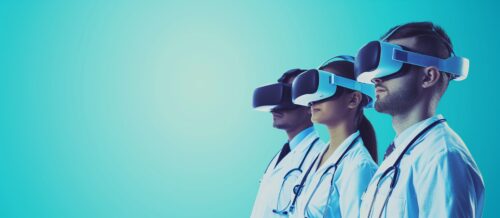
latest
Raising standards and driving efficiencies – how immersive technology is transforming health care education
David King Lassman is founder of GigXR, which uses cutting-edge holographic technology to provide simulation training to health care professionals. Following the publication of our XR paper, David spoke to us about how innovation is democratising learning in health care

Q: What do you think is the greatest challenge to overcome in health care?
A: There are real existential challenges across the healthcare sector, not just in the UK but across the world. As we come out of the pandemic, what we’re seeing is real fatigue and burnout right across the sector. We’re seeing people leave their profession in droves, either moving to the private sector or leaving to do other things, and that leaves a real hole. That means that the staff that remain are overworked, stress levels are going through the roof and this is trickling down to patient outcomes. I think that technology can play a really important role in addressing that challenge, and certainly, when we look at our system, we are using immersive technology to train staff across the healthcare landscape. We’re democratising simulation training through the innovative technology methodologies that we deploying, and it’s proving to be very impactful, driving efficiencies, helping with knowledge retention and preparing students for real clinical experience.
Q: What about the challenges for you as a technology company?
A: The challenge that we have is – how do you educate your market in new and emerging technologies? Even when you can point to the benefits – the efficiencies and the positive outcomes that your technology drives – very often educators who are also physicians rely on their tried and trusted modalities of training, and breaking through that friction point can sometimes be challenging. What we hear a great deal is, “When you have lots of empirical data pointing to the benefits then I’m more likely to adopt”. You get caught in this Catch-22 because in order to get that data you need adoption. We’re working with a student at Cambridge University who’s doing a PhD in the efficacy of immersive training in simulation for health care purposes, and we’re confident that the outcome of that is going to be very positive, but we’re impatient to get those data points. The good news is that a large amount of research has already been done at esteemed institutions across the world and the data is pointing to incredibly positive results, showing that using immersive learning technology in simulation training is helping students to learn faster, retain knowledge more effectively, and be better prepared for clinical practice.”
Q: What are the opportunities your technology offers that could have the greatest impact?
Simulation plays an incredibly important role in preparing learners for clinical experience and there are some wonderful methodologies of training that we rely on heavily. These include high-fidelity mannequins – plastic representations of a body – the more expensive versions of which can bleed, can have a beating heart and a sound in the chest. But these are expensive, and you need to have a technician look after them. Then you also rely on using all the paraphernalia of health care training – ripping open a sterilised catheter or an IV and then practise inserting that into a mannequin or a task trainer. One of the big wins here is that we can reduce the environmental impact of training by practising again and again and again, in a safe-to-fail environment, procedures that don’t require you to interact with actual physical equipment.
What I also love is that we are democratising this type of training. So if we think about traditional simulation, it requires bringing students onto campus into expensive bricks-and-mortar buildings. Many institutions can’t afford those things or they don’t have space for those things. What we can do by providing simulation in an immersive environment is reduce the need to stand up big physical simulation centres, and train students no matter where they are in the world. So, if students are learning remotely and they want to be part of a simulation training session, they can do so either through a headset or by using their mobile devices as a conduit on holographic content that’s placed into their room – which they’re seeing from their perspective at the same time as other people, wherever they happen to be located.
We can also use this type of technology to raise standards in provincial communities or even in developing nations around the world. Cambridge University is using this type of modality of training to help train doctors in South Carolina and Africa and Uganda, for example, so we can set up a simulation training session and invite participants from all around the world and give them exposure to this type of training that they wouldn’t otherwise have had. One of the things that I found shocking [in the UK] is that carers in the community might visit an elderly patient in their home – and let’s say that patient has a leg wound and the dressing needs to be changed. Those carers can’t change that dressing because they’re not qualified to do so, so what does that mean? That means that elderly person perhaps needs to be picked up by an ambulance, taken to a medical facility, and that simple procedure of changing their dressing needs to be done by a health care professional, and then they’re driven back to their home. What if we could train those carers in the community to do simple tasks like changing the wound? And you could train them by running simulation training sessions remotely? I dare say within a handful of sessions they would be perfectly qualified to change the dressing on a wound that a patient might have on an extremity, for example, and if we think about that little tiny piece of upskilling and the efficiencies that would drive across the NHS, this would be enormous.
Q: What does good look like and how do you measure impact?
One of the great benefits of technologies like this is that you’re able to extract a huge amount of data from the way students are participating in their training, and we can use that data to analyse behaviour and outcomes, to the extent that we can develop personalised training modalities for students to help them in the areas where they most need help. We are thinking today about how we bake in things like assessment. So proctoring that’s done algorithmically, for example, would be highly impactful in reducing the burden on physicians to oversee students being tested on very routine procedural training. We’re only scratching the surface of those efficiencies and they’re only going to get deeper and broader and more impactful as time goes on.
Q: What is the most innovative application of extended reality technology in health care education you have come across?
I’m going to be totally self-serving and say our system. There are some great virtual reality applications in procedural-based training but they tend to look a little cartoony. I think we are a fantastic expression of extended reality because we rely exclusively on the mixed-reality paradigm. We believe that the best form of education, particularly in health care, is done in a connected fashion where people are together. We can use mixed reality for things like interprofessional training so that nurses are trained with physicians and anaesthesiologists to help drive a positive outcome. If we can make things better, then patients are going to be the ultimate beneficiaries. What I love about our system is that connected learning experience, but also the way in which we’re able to mimic real-world situations in a way that is proven to prepare these students for clinical engagement, and that’s incredibly satisfying for me as an entrepreneur.
Q: How does your role and organisation fit into the bigger picture of large-scale adoption?
I think immersive learning will become part of the fabric of the way that we train our medical professionals. How do we spit out better doctors and nurses and how do we do it in an efficient way, and how do we keep them engaged? I think the folks that are coming into medical school now, are the young people who have grown up with technology. They’re so comfortable with it. They come with an expectation that technology is going to be at the core of their learning, and if trusts don’t fully embrace that, I think that they will find a lot of disaffected, disenchanted students saying, “Come on, we can do this differently”.
I’m working with this wonderful obstetrician in the Midwest. She is originally from Botswana and she says that c-section in Botswana is a life-or-death procedure because doctors aren’t sufficiently well-trained, and they don’t know that organs move when a woman is pregnant – and if they make an incision, they might rupture a vital organ. She says: “Wouldn’t it be great if we can build a system of training where I can train doctors in Botswana on how to do this better?” And that’s what inspires me and motivates me. There are two things an entrepreneur wants in the final analysis. One is to have been successful and that’s measured, unfortunately, in dollars and cents. But also you want to leave some sort of legacy, and I think it would be wonderful if a company like GigXR ultimately can say, “We have this really positive impact in places where it was needed most”.
Read or download the XR in Healthcare Education paper here.

